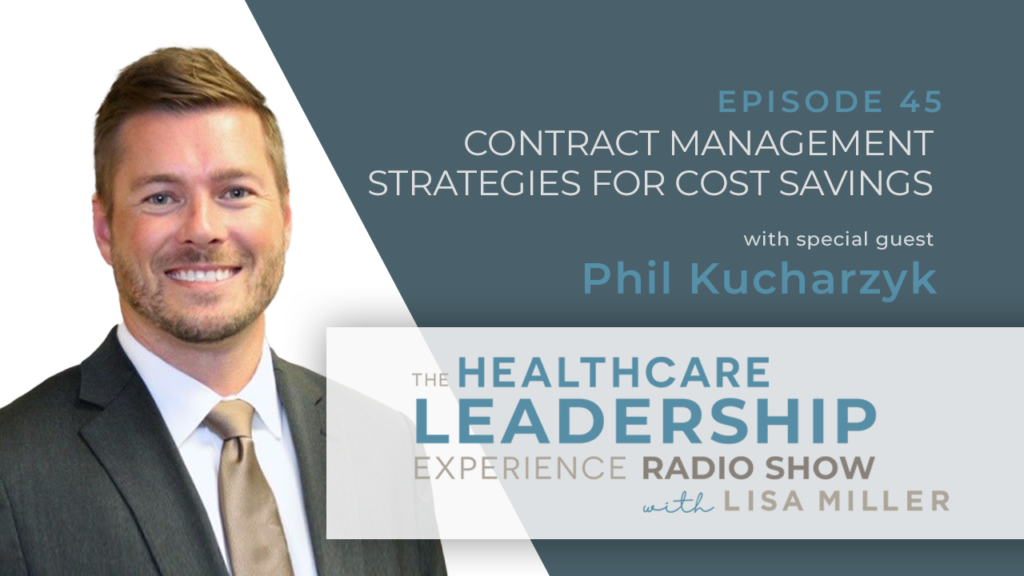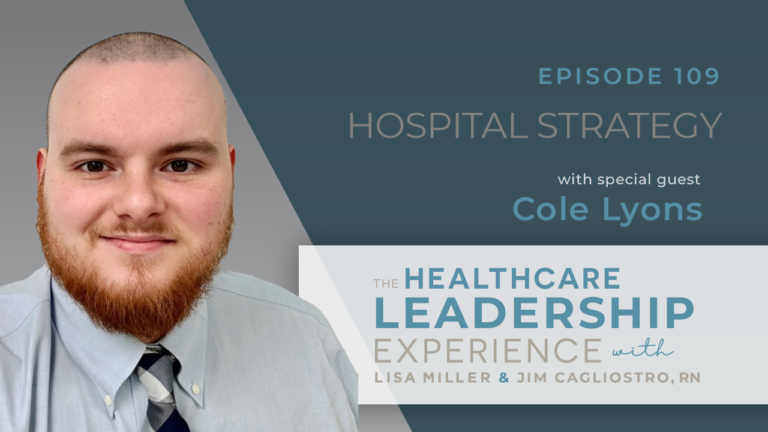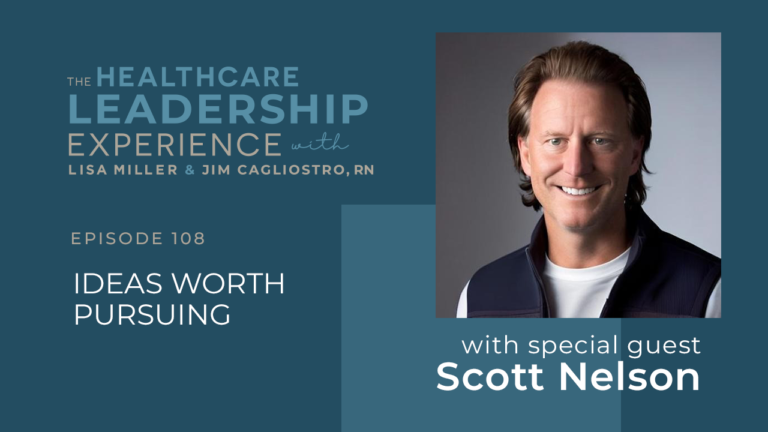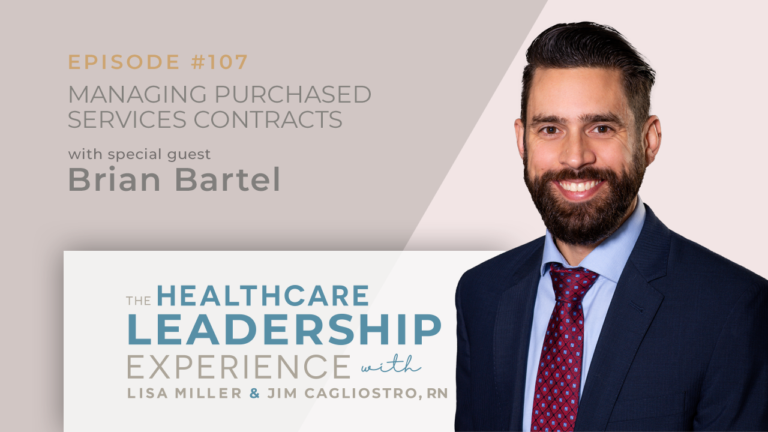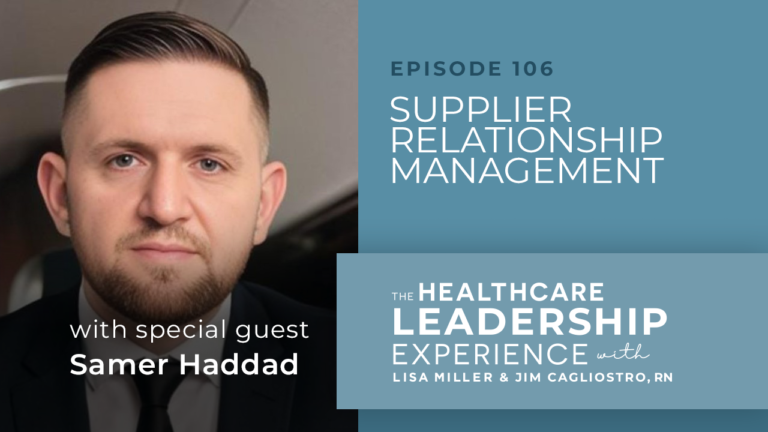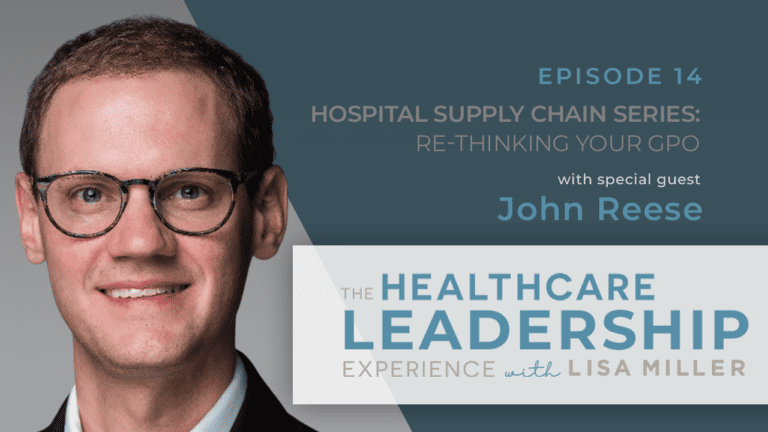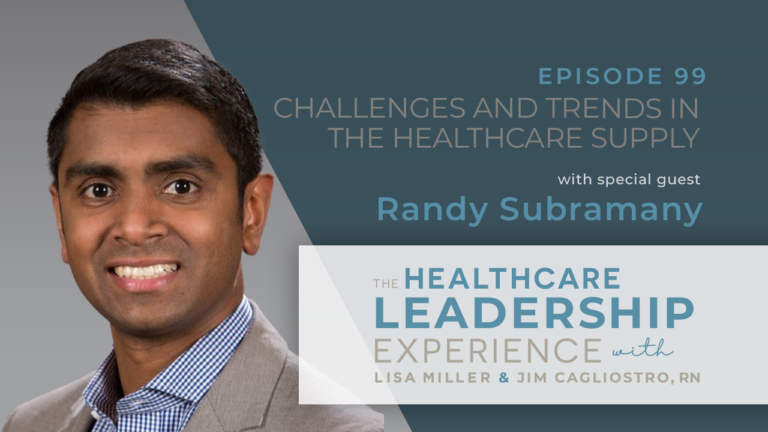The big win of data discipline: the integration of good business intelligence and analytical support to develop and deliver automated reports that are delivered proactively.
In Episode 45 of The Healthcare Leadership Experience, Lisa is joined by Phil Kucharzyk, System Director of Contracting at Bronson Health, to discuss effective contract management strategies for cost savings.
Bronson Health has collaborated very closely with Kalamazoo Valley Community College (KVCC) and the college has developed a new campus adjacent to Bronson’s downtown Kalamazoo hospital.
As Lisa observes ‘’I don’t know sometimes if even the departments understand what the supply chain can offer through market intelligence, through all these things that you could support them for their success.’’
This episode is sponsored by VIE Healthcare Consulting® which has proudly helped hospitals save $772 million since 1999.
In This Episode You’ll Hear:
- Why collaboration is the foundation for identifying successful cost savings opportunities in contract management.
- The advantages of developing ‘’knowledge experts’’ in contracting. “We’re able to say, how can we discuss where (these opportunities) might fit on everyone’s time horizon and resource them appropriately? And what other variables do we want to dig into that help us prioritize those?’’
- The role of trusted relationships in breaking down silos and why there’s much more to it than simply approaching people with cost savings ideas at contract renewal.
- How healthcare data analytics supports cost management conversations with both vendor partners and collaborators. ‘’We provide reports to our contracting team where they can look at their departmental spends. We monitor spikes and sags and use that information to have productive conversations.’’
- The ongoing challenge to prioritize and perfect full utilization and why hospitals need to ‘’lean in and roll up the sleeves’’ to use materials management systems.
- Why having your own data analysis is a requirement – and why data is a ‘’source of truth.’’ ‘’You always have to act in your own interest… so that you have your own data, your own analysis as you have the discussions with vendors. It’s so important.’’
- The big win of data discipline: the integration of good business intelligence and analytical support to develop and deliver automated reports that are delivered proactively.
What To Do Next:
- Subscribe to The Cost Advantage for Healthcare Leaders and receive a special report on 15 Effective Cost Savings Strategies
- Learn more about the simple 3 step process to work with us.
- If you are interested in learning more, the quickest way to get your questions answered is to speak with one of our margin improvement experts. Schedule a call with our team.
Connect with Lisa:
📱 https://www.linkedin.com/in/lisamiller/
Episode Transcripts
CLICK HERE TO DOWNLOAD THE PDF TRANSCRIPT
CLICK HERE TO OPEN THE TRANSCRIPT
Introduction (00:02):
Welcome to the Healthcare Leadership Experience Radio Show with your host, Lisa Miller. Lisa is an entrepreneur, inventor, advisor and founder of VIE Healthcare Consulting, the leading healthcare advisory and analytics firm, helping hospitals accelerate their margin improvement goals. Lisa loves to think differently and collaborates with leaders and their teams to solve challenges and to create new innovative approaches that impact the clinical and business side of healthcare. Our show will bring you leaders and innovators within healthcare and across multiple industries. Be a part of the discussion that will give you a unique perspective, deep insights and roadmaps to successfully help you navigate the clinical, financial, and operations of healthcare. Your show starts now.
Lisa Miller (00:49):
Hi, this is Lisa Miller and you’re listening to The Healthcare Leadership Experience Radio Show on Healthcare NOW Radio and today’s guest is Phil Kucharzyk and he is the system director of contracting at Bronson Health. And we are really excited about our conversation today. Welcome, Phil.
Phil Kucharzyk (01:08):
Thank you, Lisa. I’m excited to be here. Thanks.
Lisa Miller (01:10):
Great. So, I want to begin with your story, your background, because very interesting is you are starting on your 21st year at Bronson Healthcare in Michigan, and you’ve had some great positions and I think the audience would love to hear about you, your career, and some things about Michigan. So, if you can start us off, that would be great.
Phil Kucharzyk (01:37):
Oh, yeah. I’m looking forward to it. Yeah. So, I was born in Southwest, Michigan in St. Joe, where Whirlpool Corporation is, down in that neck of the woods. And so, Kalamazoo is about 45 minutes east of there. And Kalamazoo is directly between Detroit and Chicago, about 145 miles either direction. So, you’ve got really quick, easy access to both of those areas, but Kalamazoo in and of itself has been great. I attended Western Michigan University and I’ve stayed here after I graduated. I was fortunate enough to have an internship with Bronson my last semester. And I was just kind of rolled into a bunch of really great positions. It’s a tremendous organization that’s really focused on growth and support, and it’s been a lot of fun.
Phil Kucharzyk (02:21):
Kalamazoo, in general, has a really rich history too, between Western and Kalamazoo College is in the area. Gibson guitars were manufactured here, striker medicals in our background, Pfizer also a huge footprint here too. There’s a rich history in the area that’s really helped create community too. So that’s been a huge part of our organization is community-owned healthcare system. And so it’s been really nice to have that community support on a lot of different fronts and the ability to promote healthcare equity in our communities that we serve. So it’s been a really fun ride so far.
Lisa Miller (02:57):
That’s great. And I love community medical systems because they really are the backbone or the footprint to the communities themselves. And they’re so vital and important for so many different reasons and I have a particular passion for the work that community medical systems have. And like you said, it’s equity and healthcare, it’s social determinants, you play such a significant role, important role to your community. So you also have some other unique challenges’ being there somewhat independent on your own.
Phil Kucharzyk (03:32):
Yeah, that’s true. We’ve stretched from Battle Creek kind of to our East, to South Haven, another lake shore community to the West. And so we’ve got a pretty solid county region that we support and it’s really nice to talk about how we contribute to access for all those consumers in those areas and bring them quality outcomes. And so that’s just a really neat thing to be a part of in it and really attaches myself to the community when everybody’s focused on that endeavor, and we can put our contracting and purchasing practices in motion that helps support that just as a really broad goal.
Lisa Miller (04:03):
Absolutely. It’s the business of healthcare is supporting the outcomes of the organization. So I couldn’t agree more. So I have a couple of questions for you around your role in contracting, and there’s so many different facets, but for today’s purpose, it’s really going to focus around cost savings opportunities. So can you give us your framework, your thinking around how you identify cost savings opportunities?
Phil Kucharzyk (04:30):
Yeah, it’s always an evolving conversation and it’s definitely one that has presented some challenges in the last couple of years too. So I think what we’ve really been able to do is build a lab of collaboration. And I think that’s been a really important piece to how we prioritize and work on contracting endeavors. And it’s really put a premium on communication too, especially with a lot of work from home teams or with not as much access to some of our collaborators that we’ve had in the past. So I think those are two really significant things that we’ve been able to enhance that have really lent us to be able to design a contracting strategy. We try to look at two or three year cycles. Our team, we’re blessed to have a really adept team where we’ve been able to develop some knowledge experts in a contracting realm.
Phil Kucharzyk (05:16):
So we’ve got focused contracting folks that have departments that they’re responsible for, and with that experience, they’ve been able to really develop a sound understanding of the product markets for those areas and we’ve built great relationships with our clinical collaborators and creates this really rich environment to be able to say, hey, these are opportunities that we see and how can we discuss where they might fit on everyone’s time horizon and resource them appropriately? And what other variables do we want to dig into that help us prioritize those? So, I think data has just been a huge enhancement that we’ve been able to achieve probably in the last five plus years, really explicitly, but it’s been something that we’ve really tried to prioritize. The whole time that I’ve been in the department we’ve always had a really good approach to using data to drive our decisions and objectives and opportunities too.
Lisa Miller (06:09):
So I want to take a step back on, you talked about your team and that their knowledge experts, which I love that wording and that they’re in place in that way into your team and the fact that they work with specific departments, I think there’s a lot to that Phil, because for a couple of reasons, right? So if they are working with the lab as one example, there’s a lot of trust that gets built back and forth, right? So they’re just not coming to them when there’s a cost saving doctor. So you build this trust and like you said, they really go deep with their expertise. They’re not just skimming the surface. So can you talk a little bit about that approach? Because I think it’s a really, really smart approach.
Phil Kucharzyk (06:53):
I think it lends a lot to building really trusting relationships. It is more so than just approaching people with cost savings ideas, but it really develops that communication path where we can say what’s important to you right now, maybe in the near term, in the future, and just to have that awareness and the ability to discuss what those potential next endeavors might be, really lends a collaborative… It’s really a big team, outside of our team, it’s just really drawn in additional teammates. And I think everybody starts to understand where that teammate can help support them and whatever their day-to-day activity is, or their long-term planning, or as they’re trying to bring some decision making information together, we can help do that with market information on products or equipment. And that’s just been a really productive way to be efficient and effective.
Lisa Miller (7:44):
So I’m going to go a little deeper on what you said too, because it’s a lot of very important information. And by having those trusted relationships, you break silos down, right? We always hear about, oh, that contract outside, we weren’t aware of it. Or that department just wants to not have anybody in their playground area or whatever that case may be. But those relationships break silos, which is so important, particularly in areas like purchase services, right? Lots of departments are making decisions. So you really break through that barrier. Also, you’re looking towards the future. So you’re not coming up on a contract that you have two days to review. It sounds like you really are preparing for the future because you’ve got this relationship, so you’re able to be prepared. And then the third thing that I heard you say is that you’re able to communicate to the departments what you can offer. I think that’s huge. I don’t know sometimes if even the departments understand what the supply chain can offer through market intelligence, through all these things that you could support them for their success.
Phil Kucharzyk (08:47):
Yeah. It’s really that communication’s so key because when we’re inquisitive and we ask as a partner, it helps us understand what are requirements that we should talk to our vendor partners about fulfilling, and it can help bring a lot of clarity and focus to all parties so that our vendor partners can work on a solution that fits exactly what we’ve asked for and that can really lend to solid decision-making and can streamline the process too. I think we always talk about we don’t want to waste in any format, whether it’s finances, whether it’s time, energy, we just want to be really as efficient as possible and I think that’s one way that we can accomplish that is having really good defined requirements and then translate those. And then there’ll be information that we receive back that’s outside of those that we can consider and say, gosh, we didn’t know that was available and how does that fit into our decision-making now or in the future potentially too?
Lisa Miller (9:40):
Yeah. It’s a great conversation around how do you identify those opportunities and how do you work with the departments and that needs to be not just like a one time in a year, one time when the contract comes due, but it’s a relationship that builds over time. And I think that’s a really, really great framework and a great system that the way you’re approaching it at Bronson. So to follow, how do you prioritize opportunities? Right? So hundreds of vendor partners, agreements, like you said, you do contract strategy, you cycle two to three years, but there’s still this prioritization that you’ve got to plan, right?
Phil Kucharzyk (10:19):
That’s a real good balancing act because we’ll identify within purchasing and contracting some priorities potentially based on contractual relationships. And then I think it’s just how do we marry that up with what do we have available organizationally for time to pursue alternatives or for assessment. And so I think one thing that we’ve started to become a lot better at, and I think this is through that collaboration is trying to identify all the stakeholders in these discussions, engage with them really proactively to say, if this were an opportunity, what kind of team would you need to assemble? What kind of support would you be able to lend and how much of your team’s time do you think would need to be invested in this activity?
Phil Kucharzyk (11:03):
And then we can roll all that together and look at opportunity costs just from an organizational standpoint. If we bring all these people together, what’s our perceived outcome going to be? And does that hit the mark to put this at the top of the list, in the middle of the list, or to table it for the future? And so that’s always going to be a developing conversation and we’ve just been trying to continue to get better and better at it as we go forward. And that’s really exciting because I really like working with people just in general and to have that collaboration is really fulfilling.
Lisa Miller (11:35):
If you’re just tuning in, you are listening to The Healthcare Leadership Experience Radio Show on Healthcare NOW Radio, and I’m Lisa Miller, your host. This show was sponsored by VIE Healthcare Consulting, the leading healthcare advisory and analytics firm, helping hospitals accelerate their cost savings and margin improvement goals. We’ve been helping hospitals since 1999. And you can learn more about VIE Healthcare at viehealthcare.com. So it just makes me think of something and it’s a little off to the side, but I think that’s what really drew me to have this conversation with you on the podcast and I really appreciate you joining me is because you have such an excitement and passion for your work and you and I have been kind of just talking about industry topics and you’re just so passionate and you love your work and you love what it means and you’ve tied meaning as we all should to the outcomes.
Lisa Miller (12:28):
And today I had to get blood work and actually my mom went with me, we both had to get blood work and she was great. She usually were kind of tough to get blood and she did such a great job. And I mentioned it. I’m like, wow. Usually, it’s really tough for my mom and it’s tough for me. And you were just fantastic because I’m excited and I love what I do. And I think when you love what you do, this is her telling me that you really look for the ways to do it better or I’m really focused on caring for the patients and I’ll get on the floor and I’ll do whatever it takes. And I’m like this is just fantastic. And here she is, she loves what she does, 11 years and loves it. And that makes a difference. And even she said it, because I see other people, they kind of don’t like it and they’re probably not as good as it. And I just want to mention that just the fact that you love this work, I think it’s really important to the results that you achieve.
Phil Kucharzyk (13:24):
We kind of have a joke amongst our team that we enjoy this work because we do it all the time. It’s kind of an extension of how we live like whether we’re trying to bring groceries in the least amount of trips or we’re out buying a new TV or whatever the thing is, we deploy these same strategies just in our daily life. And so when you see the success that trace and where to find the best deal on something relative to what you’ve identified as what’s important from a feature and function and all that stuff, it just becomes you’re just doing it all the time and maybe it’s chasing a deal that’s exciting or recognizing the lack of waste that comes out of an endeavor like that. You don’t feel like you’ve overspent for something or that you’ve found whatever it is that hits your requirements list.
Phil Kucharzyk (14:11):
So I think what makes it even better is to be able to then trace that into something as personal as healthcare and to see people have positive experiences in our organization and friends that I have in the community. I’m always curious how their experience was within our system. And I love to hear all the positive remarks and all the things that they are excited about based on that event and it just brings it all together for me because then not only do I enjoy what I do, but then to hear other people with their gratitude for what they experienced from my organization makes me feel like on a small level, I helped contribute to that. And it does start with people. Having great people that really care for the community is really the starting piece of it, and being able to support that is just really the icing on the cake.
Lisa Miller (14:59):
Yeah, that’s great. And I think it’s a reminder for everybody in the operations, the business side, the sourcing side, how this all connects. I think that’s great. So we have a couple of questions. You mentioned data earlier. So I would like you to talk through how data supports your cost management, cost savings, what you are using doing in data. Because I actually think that while you’ve been using a lot of data and your approaches for several years and most people are in that process now I think it’s still emerging. I think people are still trying to figure it out, Phil. So if you can talk through some of that with us.
Phil Kucharzyk (15:39):
Yeah. You know, I think we’re always trying to assess our application that we use for materials management to see the many gaps where we could have better information that comes out of that, but just the teams that we’ve been fortunate enough to assemble that are really analytically focused and have technical expertise, we’re really able to provide reports to our contracting team where they can look at their departmental spends and we can monitor spikes and sags and use that information to really have productive conversations with our vendor partners about really evolving utilization and secondarily it’s another great conversation starter with our collaborators. As we’re working on topics internally, we can bring this utilization information to the departmental leaders and to the users of those supplies and just show in black and white usage information, how much we use of certain things and what that cost adds up to over a 12-month cycle.
Phil Kucharzyk (16:36):
And that can be really eye-opening and create some really good opportunities to trace product use for opportunities to either conserve or utilize less or to maybe demand match a little bit differently with other available products. And it’s another great piece of information to bring into that conversation. So that’s another topic that we’re just consistently trying to stay ahead of and to have better and more information. And I don’t know if we’ll ever satisfy our appetite on that front, but we’ve got some really great teammates that are there bringing that information together and it really helps us be proactive.
Lisa Miller (17:11):
It’s true. It is very helpful to be proactive and really on the vendor side, they have teams of people performing these data analytics to know spending, what you’re evolving utilization is, what your spikes and cycle is, they know very well. And it’s so important that it is a partnership relationship, but you and I were talking earlier and I love this thing that you said, you always have to act in your own interest, right? So that you having your own data, your own analysis is useful and almost a requirement necessary as you have the discussions with the vendors. I mean, it’s so important. Right?
Lisa Miller (16:29):
So one of the reports we love to request is a contracting report and really going into the details into this contractor report. I would say in our experience, there are thousands of items in this report, and we see an error rate of 4 to 6%. So on average, around 5% error rate. So think about it. Think about your own spend. If you have a $10 million Medsurg spend with your distributor, or you have a $50 million spend, I mean, think about what a 5% error rate could mean to your organization. So it’s really about getting this report, understanding every single supply item, what contract that’s tied to.
Phil Kucharzyk (17:51):
Very true. Yeah. We always like to think of our data as our source of truth and the more effort we can put into having clean information. That’s why I think using our materials management information system up to its capabilities has been a really important endeavor that we’ve worked on. And so our information team within our purchasing department has just been really great at helping us use that system to really support what we’re trying to accomplish going forward. And that’s just a really neat thing to see how much richer information and actionable information comes out of that when we’ve developed really good standards for use and that we’ve got auditing opportunities within our users and teaching opportunities. And I learn stuff all the time on how I can even use that system better to answer questions or to make things better at the back end when we’re running reports and things of that nature.
Lisa Miller (18:46):
And that’s another really great point is everyone has a material’s management system. And are you optimizing, are you using it to the fullest capabilities? And, yes, it takes time and you’ve got to train people, but there’s a lot of functionality that probably is underutilized. And so the fact that you have prioritized full utilization, it’s the preparation that gets the results. So that’s a very important point, Phil. Thank you. It may seem, not that it’s simple, but it may seem a little bit obvious, but the reality is you wonder how many hospitals could lean in, could roll up their sleeves a little bit more to utilize more of their materials management systems.
Phil Kucharzyk (19:27):
Well, that’s another application that required an investment upfront and on-going. And so, I think it’s a really good topic to ensure that we’re maximizing the return on that system as it can support us in purchasing and materials management and with our end-user teams too. So, I just think it’s a great tool that we have to really help us identify and drive our prioritization schedule.
Lisa Miller (19:50):
That’s great. So as we wrap up and I have to say, I’m a little disappointed that I don’t have more questions, but we’re also running out of time. You’ve had so many years of experience working with your team and I’m sure you’ve had a lot of successes over the past few years. Could you talk about maybe one of your most proud moments with you and your team of an accomplishment and whatever that may look like, savings, implementation, outcomes, a big win for you and your team?
Phil Kucharzyk (20:21):
Yeah, I think there’s a few of them on there, but I would probably fall to I think we’ve really been able to integrate a lot of good business intelligence and analytical support. And I think that those pieces when we bring them all together, we really strive our information team within purchasing has really helped us develop and deliver automated reports that we can count on that are delivered proactively. And so some of my past roles a long time ago was an activity that we would have to do as an individual where you would assemble and mine all this information and we’ve been able to get to a point where based on feedback from each individual on how they go about structure and their prioritization wheel themselves, or what information that they use. We were able to distill all that down and create really sound reports that satisfy a lot of everybody’s requirements.
Phil Kucharzyk (21:14):
And now they’re just on a cadence where people can bank on. Every time I ask for one special, I’ll receive it like this, or every month I’ll receive a proactive dissemination of these certain factors and topics. And so I think on your point on data and information just constantly being a huge part of our work, it’s been nice to see us polish that wheel a little bit more and make it roll a little bit easier for everybody so that we can focus on high value activity with our contract teams. It’s just been a huge win recently.
Lisa Miller (23:40):
So that’s really big. I mean, I would be really proud if I was able to say that. So you have very specific customer reporting or business intelligent data that is created and is just outputted on whatever basis, monthly, quarterly, that everyone can expect. That’s a big, big win. And once those are created and really it’s push of the button and maybe work definitely on the front end. But what happens is, those users, the department directors, your team gets used to that, gets used to thinking with the data and those decisions become completely different. You almost really can’t make that decision until I see this report versus sometimes making decisions a little more on the fly, but that’s a big win Phil. I mean, to really implement that kind of data cadence and that data discipline.
Phil Kucharzyk (22:38):
We felt really fortunate to be able to have a team with that kind of expertise and their ability to not only be really data-oriented, but to understand supply chain and to understand how the rest of our teams are using that information. It makes that initial build and the output a lot easier because they can forecast as if they were sitting in those other roles and know how to use that information and I think it makes it a really effortless kind of task on the front.
Phil Kucharzyk (23:05):
I say effortless because they make it seem effortless, and I can’t imagine how much hair pulling comes out of it sometimes, but it’s kudos to the team that really digs into that information and can really streamline its assembly and dissemination and it’s just really appreciated. And I think it really helps everybody have that specialization lens where they know that I can specialize on maybe some of the strategic parts of my role or assembling more market information, because I know that there are really solid teammates that are going to give me that assist with this data and with the information. And it’s just a great handshake and a good partnership on those team.
Lisa Miller (23:41):
That’s great. That’s a great win. So, Phil, I really appreciate you being on the show today and you’ve given everybody a lot of tangible, tactical, and strategic things to think about. Maybe assess, just self-assess of where they are, but you’ve been generous to give everybody some insights into your work. So thank you for being on this show today. We appreciate it.
Phil Kucharzyk (24:05):
Oh, thanks a lot, Lisa. I appreciate it. You know, I’ve had good experiences across a lot of different areas in contracting and supply chain. So I’ve been able to learn a lot and there’s been really great industry mentors that are out there that I’ve learned from that. This is just kind of a by-product of all of that and bringing it together. And so, it’s really great to be able to share. And I really appreciate you having me on this morning.
Lisa Miller (24:26):
That’s great. So you’ve been listening to The Healthcare Leadership Experience Radio Show on Healthcare NOW Radio, you can learn more about Phil. We have some show notes. You can reach out to him on LinkedIn. Of course, he is the system director of contracting at Bronson Health and we appreciate Phil being on our show today. You can listen to us on Healthcare NOW Radio and also on Apple Podcast and other podcast apps. We look forward to having you join us on future episodes.
Outroduction (24:54)
Thank you for joining Lisa Miller for this episode of The Healthcare Leadership Experience Radio Show sponsored by VIE Healthcare Consulting. If you enjoyed the show, subscribe so you can automatically get notified when new shows premiere weekly. Don’t forget to leave us a review so more healthcare leaders like you can discover us. This show is on HealthCare Now Radio, Apple Podcast, Stitcher, Spotify, Pandora, and other major podcast platforms. To reach out to Lisa personally, you can join the conversation on LinkedIn, where Lisa continues to have discussions on the business of healthcare. You can find links to Lisa’s other social platforms in the show notes or at viehealthcare.com. The Healthcare Leadership Experience Radio Show is the think differently communication for healthcare leaders, and we are honored to have you tune in. Join us next week for another episode of The Healthcare Leadership Experience Radio Show.
